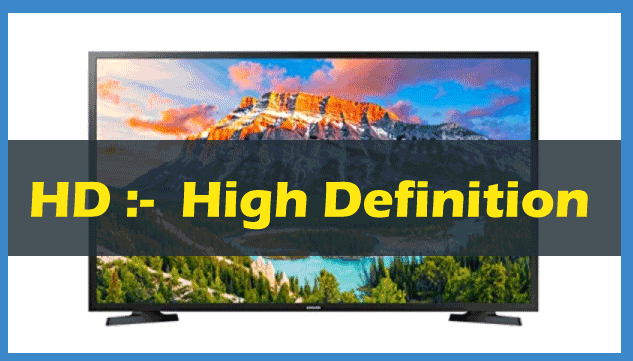HD Full Form
HD Full Form: HD stands for High Definition. It refers to High Definition images, which means an image that is more clear, more comprehensive, and larger. So high definition is a resolution, a standard measure of the picture, videos of a television, web camera, laptop, mobile phone, etc., on which the picture quality depends.

Now, the question is what makes an image, High Definition? It is the pixel, and by the number of a Pixel, the resolution of an image is determined. If the number of pixels will high, the picture will be more apparent in respect of the low number of pixels, so more pixels more precise images. High-resolution images are with more pixels per inch make a higher quality of videos and photos. In contrast, low-resolution images have a low number of pixels, which makes low-quality of photos a blurred image not very clear. The printing quality of such images is inferior, while this high resolution makes the printing quality very clear.
Further, the pixel of high-resolution images is considered a minimum of 300 pixels per inch. The Graphic industry used this for high-quality pictures. This resolution makes the print quality suitable. It is vital for hard copies as well for the representation of a brand and other printed materials.
Further, the best image resolutions for videos should be 1280x720 (for landscape), 720x1280 (for portrait), and 720x720 (square). However for the best quality of picture, the pixel dimension should be about 1024 pixels wide (for a horizontal image). While the standard resolution for web images is 72 PPI (often called screen resolution).
Image sizes
Moreover, there are some most common image sizes for the web:
- 1920x1080 pixels: This is HDTV format. This standard size can be seen in High Definition TVs, Presentations, and Social Media Cover Photos. It follows the 16:9 aspect ratios.
- 1280x720 pixels: This is HD format. This standard size can be seen in photography and film. It follows 16:9 aspect ratios.
- 1080 x 1080 pixels: This is used for social media posts like; Facebook and Instagram as well as for Profile Pictures. It follows 1:1 aspect ratios.
Further, we can see the quality of HD images through HDTV; for example, if we see a cricket match on HDTV, we can see everything more clearly, like the players, Balls, Grasses of the ground, even the Supporters sitting in the background. In HDTV color of the grass looks greener and attractive. While the same thing if we see in SD TV we can’t get that quality like HDTV. The difference is only because of high resolution. HDTV has (1080x1920) pixels, while SD TV has (720x576) Pixels. So we can see the differences and the quality of HD.

Advantages of HDTV
- Any program like Movies, Cartoons, Discovery, Documentary and Sports on HDTV is of better quality.
- It provides vivid colors with a wide range of hues.
- It uses a 16:9 wide-screen format, which is used in movie theaters.
Moreover, there are 3D, a step forward to HD and ULTRA HD the Higher Level Definition with the resolution of 3840x2160 (8.3 megapixels), as well as with a resolution of 7680x4320 (33. 2 megapixels). But still, markets are full of HD, as 3D is mostly used for theatre and ULTRA HD for displaying national and international games, as well as presented by all leading producers at the trade fairs.
So, overall, HD images play an essential role like, in the present pandemic scenario, the entire education system has become dependent on online education, so if we use HD for teaching children, it will make them more transparent and, they will be able to understand in a better way.